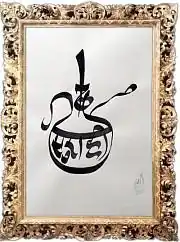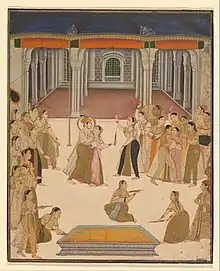Ganga-Jamuni tehzeeb
Ganga–Jamuni Tehzeeb (Hindustani for Ganges–Yamuna Culture), also spelled as Ganga-Jamni Tehzeeb, is the culture of the central plains of northern India,[1][2] especially the doab region of Ganges (Ganga) and Yamuna rivers, that is a syncretic fusion of Hindu cultural elements with Muslim religious elements.[3][4][5][6][7][8]

| Part of a series on the |
| Culture of India |
|---|
 |
| History |
| People |
| Cuisine |
| Religion |
| Sport |
|
K. Warikoo, Professor at the Centre for Inner Asian Studies at Jawaharlal Nehru University describes the concept as one exemplifying communal harmony and a shared culture between the Hindus and Muslims of India:[9]
Ganga-Jamuni Tehzeeb compares the Hindu-Muslim harmony and friendship to the holy confluence of India's major rivers - the Ganga and Yamuna. It assumes a peaceful merging of Hindu and Muslim culture and lifestyle in Banaras as expressed in their friendships, joint festivities and interdependence. As such, the Ganga-Jamuni Tehzeeb reminds people of the incomparable unison they share across religious communities. This in turn sets a parameter for the people to uphold the religious peace. The metaphor is especially popular in the intellectual discourse as it coincided well with the Nehruvian rhetoric of a composite culture.[9]
Ganga-Jamuni tehzeeb, a poetic Awadhi phrase for a distinctive and syncretic Hindu-Muslim culture, is reflected in the fused spiritual connotations, forms, symbols, aesthetics, crafts and weaves, for example Kashmiri Muslim carpet makers feature Durga in their patterns, Muslim sculptors making idols of Durga, and Hindu craftsmen create the Muharram tazia.[8][10] This religious syncretism based on the vasudhaiva kutumbakam, unity in diversity and multi-communitarianism is a result of centuries of interfaith exchange and accommodation among Indian religions (Hinduism, Buddhism, Jainism, Sikhism) and foreign origin religions (Muslim and Christian) where in India communities preserve own cultural and religious identies while facilitating the shared celebration of festivals, customs and traditions.[10] The shared Indian national identity is separated from the personal religious identity where nation and common social good comes first above the personal religion.[10]
Various iconic people of several religions related to the Bhakti movement, a medieval initiative for the revival and recontextualisation of ancient Vedic traditions,[11] are example of this tehzeeb.
Etymology
"Ganga-Jamni" Hindi, literally, "mixed," "composite," "alloy,"[12][13][14] "Tahzeeb", Urdu, via Arabic: تہذيب tahẕīb edification, refinement, polish, culture.
Revolutionary role of bhakti movement
Surdas, Guru Nanak, Ravidas, Kabir, Bulleh Shah, Tulsidas, Gusainji, Ramananda, Eknath, Tukaram, Mirabai were some of the prominent contributors of bhakti movement. One of the best examples of syncretic faith is captured in one of Kabir's doha (verse), "some chant Allah, some chant Ram, Kabir is a worshiper of true love and hence reveres both."
| Devanagari | Nastaliq | Roman | Translation |
|---|---|---|---|
| कोई जपे रहीम रहीम
कोई जपे है राम दास कबीर है प्रेम पुजारी दोनों को परनाम |
کوئی جپے رحیم رحیم
کوئی جپے ہے رام داس کبیر ہے پریم پجاری دونوں کو پرنام |
Koi jape rahim rahim
Koi jape hai ram Das Kabir hai prem pujari Dono ko parnaam |
Some chant O Merciful [Allah]
Some chant Ram Kabir is a worshiper of true love And reveres them both |
Regional practices
Awadh
Nawabs of Awadh were fore-runners of this culture.[15] The region of Awadh in the state of Uttar Pradesh is usually considered to be the center of this culture.[16][17] Allahabad, Lucknow, Kanpur,[18][19][20] Faizabad-Ayodhya,[17][21] and Varanasi (Benares)[22][23] are a few of the many centers of this culture.
Delhi
Delhi has also historically been a prime example of the Ganga-Jamuna Tahzeeb; with its iconic Khariboli dialect and being one of the literally centers of the Urdu language, there have been numerous poets such as Amir Khusrow, Mir Taqi Mir, Ghalib, Mohammad Ibrahim Zauq, Daagh Dehlvi, Nida Fazli and many others. Delhi has also contributed to the music of the region, being the birthplace of Qawwali and the Delhi Gharana. Though, there has been conflict between Hindus and Muslims after 2020 Delhi riots.
Hyderabad
Hyderabad, the capital city of Telangana in south-central part of the India, is also a big example of communal harmony where the local Telugu Hindus and Hyderabadi Muslims live with peace and brotherhood, where Hindu temples serve the dry dates fruits to mosques for Iftar Muslim festival.[24][25]
See also
- Hindu–Islamic relations
- Hindu-Muslim unity
- Opposition to the partition of India
- Phool Walon Ki Sair
- Din-i Ilahi
- Inclusivism, concept that all religions are at least partially true and none is untrue
- Sheilaism, a term for an individual selecting strands of multiple religions
- Folk religion, any flexible vernacular religion without a rigid doctrine
- Interfaith dialogue, constructive interaction among various religions
- Religious pluralism, tolerance for diversity of religions in a society
- Religious toleration, respecting and upholding others' right to behold religion
- Multiple religious belonging, a phenomenon that a person can belong to multiple religion is specially found among more tolerant societies such as Indian and Chinese origin religions
References
- Chari, Pushpa (28 July 2018). "Ganga-Jamuni tehzeeb: Syncretic ethos in weaves and crafts". The Hindu. Retrieved 23 February 2020.
- Shaban, Abdul (10 January 2018). Lives of Muslims in India: Politics, Exclusion and Violence. Taylor & Francis. ISBN 9781351227605.
- Dhulipala, Venkat (2000). The Politics of Secularism: Medieval Indian Historiography and the Sufis. University of Wisconsin–Madison. p. 27.
The composite culture of northern India, known as the Ganga Jamuni tehzeeb was a product of the interaction between Hindu society and Islam.
- Āzād Hindūstān, māz̤ī aur mustaqbil: rūdād aur maqāle, qaumī simīnār, munʻaqidah Jāmiʻah Hamdard, Naʼī Dihlī, 29-31 Agast 1998. Khuda Bakhsh Oriental Library. 2000. p. 60.
During their political rule, over a period of about 1000 years, both Hindus and Muslims lived together, shared each other's culture and gave rise to the emergence of a new type of Hindu-Muslim culture (Ganga-Jamuni Tahzib).
- Oesterheld, Christina (1996), "Deconstructing" a 'Deconstructionist' Urdu Story: "Ek Kahani, Gangaa Jamni" by Kaisar Tamkeen", Annual of Urdu Studies, University of Wisconsin Press, 11 Quote: " Ganga-Jamni may be translated as “two-colored” or “mixed” and is often used as an attribute of the composite north Indian culture, especially Indo-Muslim culture."
- Steven Wesley Ramey (15 September 2008), Hindu, Sufi, or Sikh: contested practices and identifications of Sindhi Hindus in India and beyond, Macmillan, 2008, ISBN 978-0-230-60832-0,
... the continuing joint Muslim and Hindu participation in public festivals, relating it to "Ganga-Jamun Tahzeeb," the attitude of refined hospitality and harmonious relations that historically characterized this region ...
- Socialist Party (India) (2007), Janata, Volume 62,
... the ganga-jamuni tehzeeb (composite culture) regarded both religious communities as two eyes of a beautiful bride and their long history witnessed 'give-and-take', at many levels ...
- Ganga-Jamuni tehzeeb: Syncretic ethos in weaves and crafts, The Hindu, 18 July 2018.
- Warikoo, K. (2010). Religion and Security in South and Central Asia. Routledge. p. 86. ISBN 978-1-136-89020-8.
- Understanding Ganga-Jamuni Tehzeeb: How diverse is the "Indian multiculturalism", Daily News and Analysis, 15 June 2014.
- Karen Pechilis Prentiss (2014), The Embodiment of Bhakti, Oxford University Press, ISBN 978-0195351903, pages 15-16
- McGregor, R. S. (1993), "गंगा-जमनी = mixed, composite, of whitish grey colour, made of alloy, an alloy", Oxford Hindi-English Dictionary, Oxford University Press, p. 248
- Chaturvedi, Mahendra (1970), "गंगा-जमुनी = made up of two colours or two metals (like gold and silver)", A Practical Hindi-English Dictionary, Delhi: National Publishing House
- Dasa, Syamasundara (1965–1975), Hindi sabdasagara, Navina samskarana (in Hindi), Kasi: Nagari Pracarini Sabha,
गंगाजमुनी (p. 1190) गंगाजमुनी— वि० [हिं० गंगा + जमुना] १. मिलाजुला । संकर । दो- रंगा । २. सोने चाँदी, पीतल ताँबे आदि दो धातुओं का बना हुआ । सुनहले रूपहले तारों का बना हुआ । जिसपर सोने चाँदी दोनों का काम हो । ३. काला उजला । स्याह सफेद । अबलक ; 2) गंगाजमुनी (p. 1190) गंगाजमुनी २— संज्ञा स्त्री० १. कान का एक गहना । २. वह दाल जिसमें अरहर और उर्द की दाल मिली हो । केवटी दाल । ३. जरतारी का ऐसा काम जिसमें सुनहले और रुपहले दोनों रंग के तार हों । ४. अफीम मिली हुई भाँग । अफीम से युक्त भाँग की सरदाई (बनारस)
- Descendants of Nawabs keep Holi traditions alive, The Indian Express, Tue 10 March 2009, 15:35 hrs
- Malika Mohammada (2007), The foundations of the composite culture in India, Aakar Books, 2007, ISBN 978-81-89833-18-3,
... developed in Awadh as a genre of composite creativity. ... of multiple Indian cultural traditions and provided glimpses of the Ganga-Jamuni tehzeeb of north India with Lucknow as its centre ...
- Plaint Of Ayodhya, The Financial Express, Sunday, 22 August 2004 at 0000 hrs IST
- https://m.timesofindia.com/city/kanpur/hindus-form-human-chain-around-muslim-baraat-in-violence-hit-kanpur-escort-them-to-safety/amp_articleshow/72976520.cms
- Festival has origin in city's composite culture, TNN, 13 May 2009, 06.52am IST
- Karbala revisited Archived 11 November 2013 at the Wayback Machine, Express News Service, Saturday , 12 February 2005
- Twin towns welcome verdict with humility, grace, Deccan Chronicle, 1 October 2010
- An apt reflection of Ganga-Jamuni tehzeeb, Naveen Kumar, TNN, 25 September 2009, 10.09pm IST
- Stories behind the masks, Shailaja Tripathi, NEW DELHI, 4 November 2010, The Hindu
- minhaz, ayesha (16 July 2015). "Ganga-Jamuni tehzeeb helps maintain peace". Deccan Chronicle. Retrieved 24 December 2019.
- "Ganga-Jamuni tehzeeb: Temple serving Iftar Dates to 5 Mosques in Hyderabad". Retrieved 24 December 2019.
